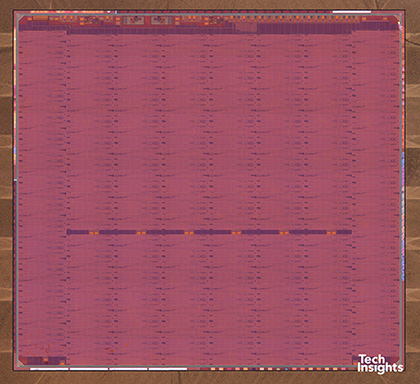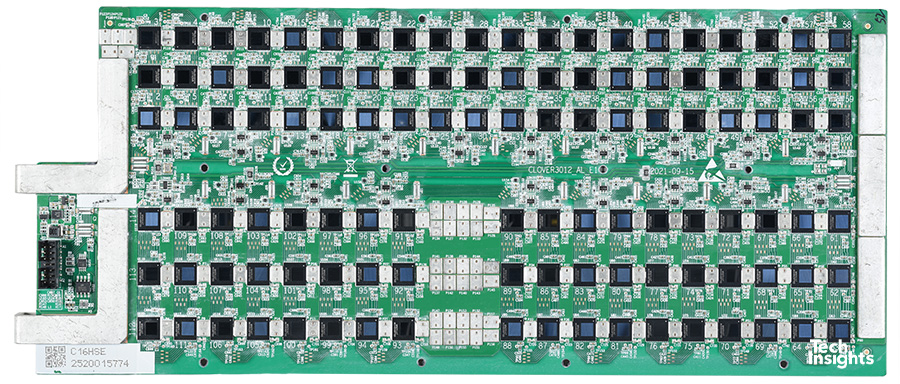China's SMIC Shipping 7nm Chips, Reportedly Copied TSMC's Tech
China's 7nm shipping silently since 2021

According to analyst firm TechInsights, Chinese foundry SMIC has been producing chips based on its 7nm process node for a Bitcoin Miner SoC, and they've been shipping since July of 2021 (h/t to SemiAnalysis). TechInsights has reverse-engineered the chip, saying the "initial images suggest it is a close copy of TSMC 7nm process technology," a telling discovery after Taiwan-based TSMC has sued SMIC twice in the past for copying its tech. The discovery comes as China continues to build out its own homegrown semiconductor production, with the heavily-sanctioned SMIC leading the way. Meanwhile, the US government is on the cusp of approving large subsidies for US-based chipmakers.
The TechInsights report says that TSMC, Intel, and Samsung have all developed much more sophisticated technology than SMIC's 7nm and are at least two nodes ahead. Regardless, the significance of SMIC shipping its 7nm process can't be overstated — SMIC has been heavily sanctioned by the US government, restricting its access to advanced EUV chipmaking tools. However, the firm can obviously use its existing tools to produce 7nm chips (and possibly smaller), albeit with less desirable economics and yield. Those cost factors are hardly a concern for China as it seeks technological independence from Western countries by developing its own supply of indigenously-produced chips.
SMIC originally announced its 7nm node back in early 2020. Later that year, SMIC and partner Innosilicon announced they had taped out a chip on the N+1 version of the 7nm node. However, it remains unclear if the Minerva Bitcoin mining chip, which Techinsights purchased on the open market, is associated with the Innosilicon initiative. At the time, SMIC claimed that it also had an N+2 version of its 7nm node in the works, but we aren't sure if the Minerva chips (seen below) use the N+1 or N+2 version of the process technology.

Taiwan-based TSMC has sued SMIC twice (in 2002 and 2006) for copying its process technology, and TechInsights' assertion that SMIC has likely copied TSMC's 7nm could lead to further legal battles between the two firms.
The MinerVa Bitcoin mining chip looks to be quite basic and measures only 4.6 x 4.2 mm, implying that SMIC is still in the early stages of chip development. Nevertheless, these types of small, simple, and relatively rudimentary chips often serve as learning nodes while the process technology is further refined:
"This low-volume production product may be the steppingstone for a true 7nm process that incorporates scaled logic and memory bitcells. Since bitcoin miners have limited RAM requirements, they likely do not feature the typical bitcell memory that the true 7nm technology definition requires (both scaled logic and bitcell adoption). This chipset likely demonstrates the logic part but not the bitcell aspect," said TechInsights.
Mining chips are perfect for working out the kinks in a new process node — as you can see in the image above, these small chips are deployed en masse to create powerful machines. In this case, the miner has 120 chips per board to create a machine that consumes up to 3300W of power. We can expect that SMIC will eventually make larger, more complex chips based on its 7nm process node as yields improve over time.
As a reminder, the process naming node convention, like "7nm," has become more of a marketing exercise for the chipmakers rather than a metric tied to any physical measurement. In the real world, a plethora of factors influence the economics and performance of a process node, which you can read about here. TechInsights is selling individual reports based on its analysis of the chip — a digital floorplan analysis, advanced CMOS process analysis, and a process flow analysis — with more details, including transistor density, to give a better idea of how SMIC's node stacks up against competing industry nodes.
The US has long prevented SMIC from procuring EUV tools from ASML and has recently explored tightening the sanctions noose even further by restricting the company's access to even comparatively-simple DUV chipmaking tools. That tactic will slow China's advance, but the country has continued to plow money into developing its own chipmaking tools and software (EDA) ecosystem. As SMIC has proven, it can use less-sophisticated equipment to create advanced process nodes even if it is less profitable, and that opens the firm up to even more sales from chip designers. Whether or not those chips will come with export restrictions due to legal challenges remains to be seen, but China has its own burgeoning ecosystem of chip designers that could use their designs in-country, perhaps sidestepping the impact of punitive measures.
Get Tom's Hardware's best news and in-depth reviews, straight to your inbox.

Paul Alcorn is the Editor-in-Chief for Tom's Hardware US. He also writes news and reviews on CPUs, storage, and enterprise hardware.
-
blargh4 Good for them.Reply
The US is going to use every dirty trick in the book to suppress China's technological and economic development, so why on earth should they play by the "rules"? -
watzupken The unfortunate truth is that it is everyone for themselves out there. In this case, US have been claiming that Huawei's 5G is used to spy on others, when US was lagging behind in 5G development back then. Yet to date, they are not not able to conclusively say (with evidence) that the spying rumor is true, while still applying sanctions on China and Huawei. And I don't believe US is not spying anyone else as well, which Edward Snowden can attest.Reply
At the end of the day, if US don't play fairly, they should not expect people to play by their rules is my opinion. -
The Historical Fidelity I hope TSMC sues and wins against SMIC. Only low morality people would think it is okay for SMIC to do this. Economic sanctions and export restrictions are legal, patent infringement is not.Reply -
blargh4 Reply
What is the "legal rationale" for the US government browbeating a Dutch tech company into not selling their products to the US's economic rivals? Who decides and arbitrates the legality of these unilateral international sanctions?The Historical Fidelity said:I hope TSMC sues and wins against SMIC. Only low morality people would think it is okay for SMIC to do this. Economic sanctions and export restrictions are legal, patent infringement is not.
....oh, the US, i see -
Groveling_Wyrm Replyblargh4 said:Good for them.
The US is going to use every dirty trick in the book to suppress China's technological and economic development, so why on earth should they play by the "rules"?
Maybe because China hasn't played by the rules in years. Thus, the United States had many reports from businesses that got their information stolen, and the U.S. got tired of all the intellectual theft, and started doing something about it.
Look at all the attempts (Over 100 times) the Chinese have used to try to copy/steal the F-16 turbine. The Chinese admit they have stolen the F-35 tech.
Years ago, a good friend of mine was contracted through his company to a Chinese company to develop wind turbine technology. The software was property of his company, and they sent him to China to help integrate the software to their turbines. About 2/3 of the way through the development, the Chinese company cancelled the contract, and sent my friend home, with no explanation. About 2 years later, my friend got a phone call to fix the software in a turbine. He showed up to the site, and there was his company's software, in use on a Chinese wind turbine. Come to find out, the Chinese had stolen the software, and marketed it as their own, with their turbines. The Chinese did not develop it. They stole it, and marketed it all over the earth.
I could go on and on.
Intellectual theft, industrial espionage, and military espionage are real. China is one of the best at doing it. It doesn't make it right. -
The Historical Fidelity Replyblargh4 said:What is the "legal rationale" for the US government browbeating a Dutch tech company into not selling their products to the US's economic rivals? Who decides and arbitrates the legality of these unilateral international sanctions?
....oh, the US, i see
Because the patents for both the method of creating EUV light and the use of EUV light in the propagation of silicon features on silicon wafers were R & D’ed and owned by both EUV LLC (a consortium of US tech companies) and the US Virtual National Laboratory. The only thing ASML holds a patent to is the end user devices they create and they were given permission to integrate EUV in their products. So yes, the US can and has declared EUV to be a sensitive technology and has the legal power to restrict the export to China any ASML device that uses tech derived from the US EUV patents. -
Kamen Rider Blade Reply
So you don't like respecting Intellectual Property and Enforcement of it.blargh4 said:What is the "legal rationale" for the US government browbeating a Dutch tech company into not selling their products to the US's economic rivals? Who decides and arbitrates the legality of these unilateral international sanctions?
....oh, the US, i see
More typical Anti-US BS.
I'm surprised you shill for China that much.